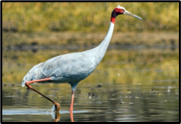Why in News?
- In February 2023, Uttar Pradesh’s Amethi district’s Mohammad Arif brought home an injured sarus crane he found in his village.
- Last week, Arif was booked under a number of wildlife laws for keeping the sarus in his possession without informing the concerned authorities.
- The bird has been shifted to a zoo in Kanpur, Uttar Pradesh.
What’s in today’s article?
- About Animal Rescue (Problems with rescuing, Legal Provisions, etc.)
- About Sarus (Habitat, Nature, etc.)
What is the Problem with rescuing Animals?
- Across the globe, rescuing wildlife at will is not permitted. This is because many such animals are not in need of rescuing.
- For example, wild cats leave their cubs to go hunting only to find them missing (rescued) on return.
- Also, many rescuers may not be equipped to either help the animals or ensure they do not become a threat to public health.
- In 2021, for example, a woman was charged for rescuing wildlife without a permit in Michigan, USA.
- The Department of Natural Resources arrested her after euthanising six of her animals, including a two-week-old deer.
Laws w.r.t. rescuing Animals in India:
- Under Section 39 of the Wildlife (Protection) Act, no person is allowed to acquire or keep in his possession, custody or control any wildlife which is state property.
- If anyone does so — for example, to treat an injured bird as in the present case — she must report it to the nearest police station or the authorised officer within forty-eight hours of obtaining such possession.
- Further, under Section 57 of the Act, if a person is found in possession, custody or control of any wildlife, the burden of proof for establishing that the possession, custody or control is not illegal is on the person.
- Clearly, the Wildlife (Protection) Act does not allow anyone to take home an injured wild bird and keep it for months without written permission from the state’s chief wildlife warden.
About Sarus Crane:

- The sarus crane is a large nonmigratory crane found in parts of the Indian subcontinent, Southeast Asia, and Australia.
- In 1861, British ornithologist LH Irby wrote about Sarus cranes he observed in Oudh (Awadh, UP) – “The young birds are easily reared by hand, and become very tame and attached to the person who feeds them, following him like a dog.”
- Called imprinting, the process starts with hatching so that the chicks follow the appropriate adult for safety.
- Given the biological inclination of the species to bond easily, individual sarus cranes have moved with people on many occasions.
- The species is neither a novelty nor under threat in the Northern Indian landscape.
- Therefore, following the letter of the Wildlife (Protection) Act blindly may set damaging precedence.









